2018 KIA K900 brake
[x] Cancel search: brakePage 434 of 544
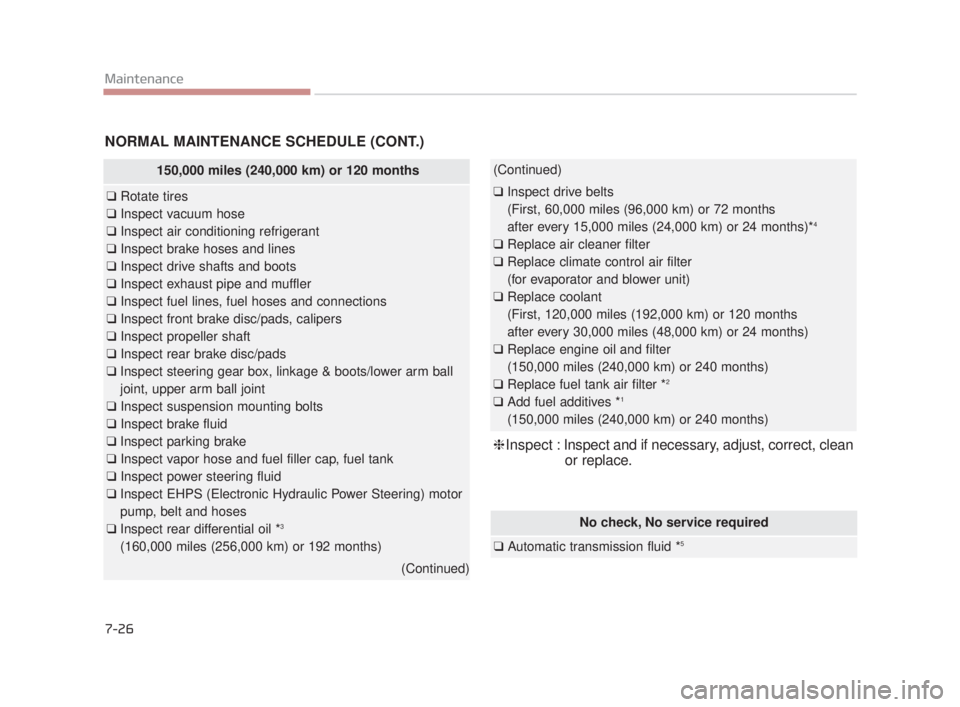
7-26
Maintenance
No check, No service required
❑Automatic transmission fluid *5
NORMAL MAINTENANCE SCHEDULE (CONT.)
150,000 miles (240,000 km) or 120 months
❑Rotate tires
❑ Inspect vacuum hose
❑ Inspect air conditioning refrigerant
❑ Inspect brake hoses and lines
❑ Inspect drive shafts and boots
❑ Inspect exhaust pipe and muffler
❑ Inspect fuel lines, fuel hoses and connections
❑ Inspect front brake disc/pads, calipers
❑ Inspect propeller shaft
❑ Inspect rear brake disc/pads
❑ Inspect steering gear box, linkage & boots/lower arm ball
joint, upper arm ball joint
❑ Inspect suspension mounting bolts
❑ Inspect brake fluid
❑ Inspect parking brake
❑ Inspect vapor hose and fuel filler cap, fuel tank
❑ Inspect power steering fluid
❑ Inspect EHPS (Electronic Hydraulic Power Steering) motor
pump, belt and hoses
❑ Inspect rear differential oil *
3
(160,000 miles (256,000 km) or 192 months)
(Continued)
(Continued)
❑Inspect drive belts
(First, 60,000 miles (96,000 km) or 72 months
after every 15,000 miles (24,000 km) or 24 months)*
4
❑ Replace air cleaner filter
❑ Replace climate control air filter
(for evaporator and blower unit)
❑ Replace coolant
(First, 120,000 miles (192,000 km) or 120 months
after every 30,000 miles (48,000 km) or 24 months)
❑ Replace engine oil and filter
(150,000 miles (240,000 km) or 240 months)
❑ Replace fuel tank air filter *
2
❑Add fuel additives *1
(150,000 miles (240,000 km) or 240 months)
❈Inspect : Inspect and if necessary, adjust, correct, clean
or replace.
KH USA 7:2018 4/14/2017 6:37 PM Page 26
Page 435 of 544
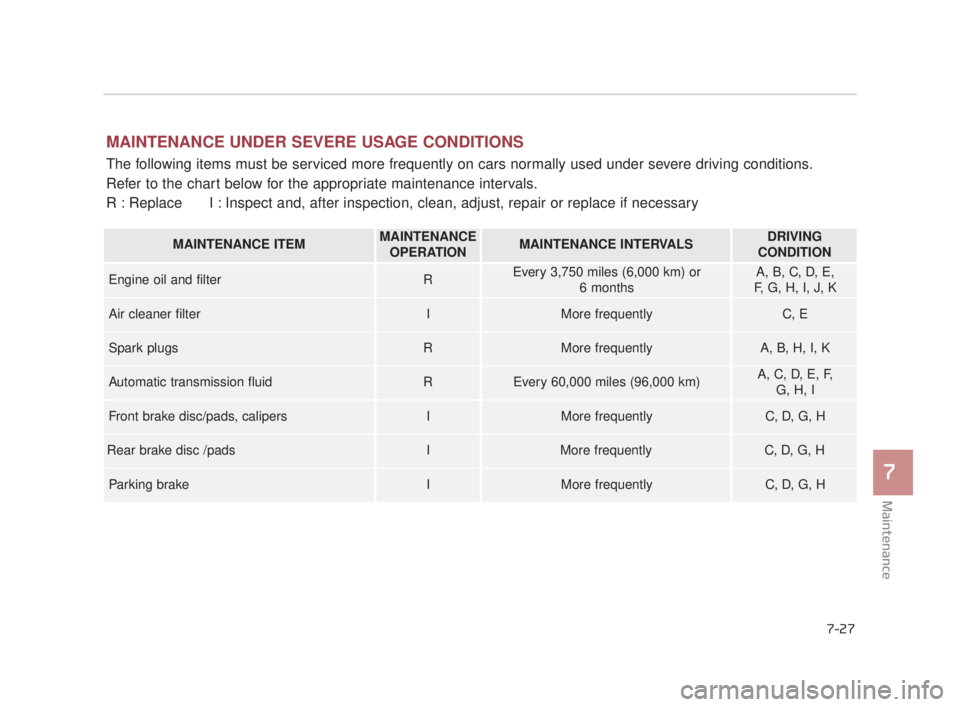
Maintenance
7
7-27
MAINTENANCE UNDER SEVERE USAGE CONDITIONS
The following items must be serviced more frequently on cars normally used under severe driving conditions.
Refer to the chart below for the appropriate maintenance intervals.
R : Replace I : Inspect and, after inspection, clean, adjust, repair or replace if nece\
ssary
MAINTENANCE ITEMMAINTENANCEOPERATIONMAINTENANCE INTERVALSDRIVING
CONDITION
Engine oil and filterREvery 3,750 miles (6,000 km) or 6 monthsA, B, C, D, E,
F, G, H, I, J, K
Air cleaner filterIMore frequentlyC, E
Spark plugsRMore frequentlyA, B, H, I, K
Automatic transmission fluidREvery 60,000 miles (96,000 km) A, C, D, E, F, G, H, I
Front brake disc/pads, calipersIMore frequentlyC, D, G, H
Rear brake disc /padsIMore frequentlyC, D, G, H
Parking brakeIMore frequentlyC, D, G, H
KH USA 7:2018 4/14/2017 6:37 PM Page 27
Page 438 of 544
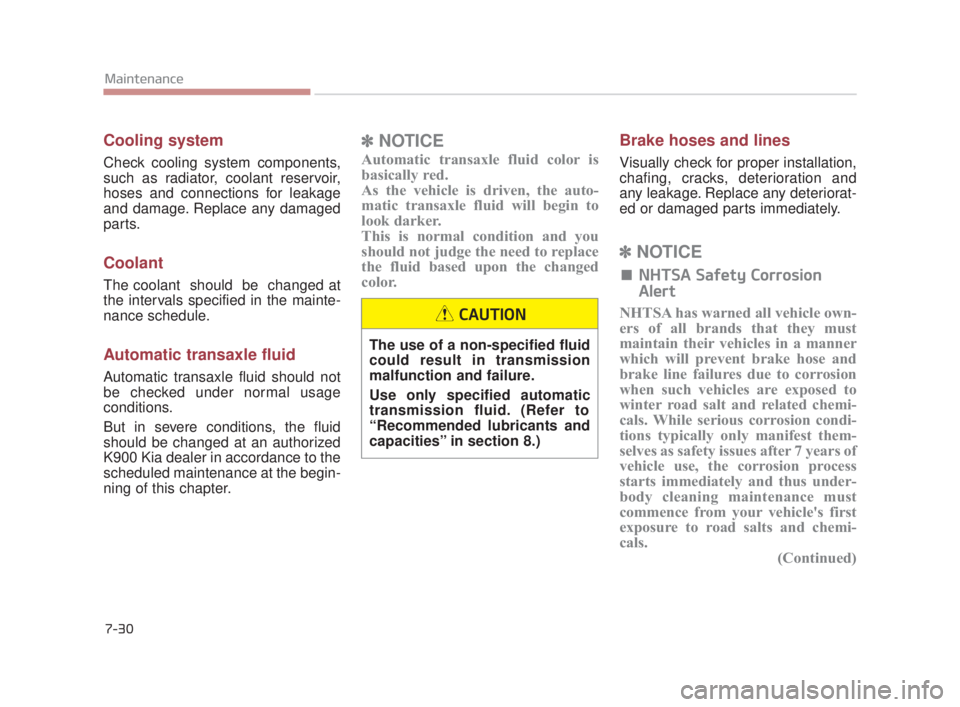
7-30
Maintenance
Cooling system
Check cooling system components,
such as radiator, coolant reservoir,
hoses and connections for leakage
and damage. Replace any damaged
parts.
Coolant
The coolant should be changed at
the intervals specified in the mainte-
nance schedule.
Automatic transaxle fluid
Automatic transaxle fluid should not
be checked under normal usage
conditions.
But in severe conditions, the fluid
should be changed at an authorized
K900 Kia dealer in accordance to the
scheduled maintenance at the begin-
ning of this chapter.
✽NOTICE
Automatic transaxle fluid color is
basically red.
As the vehicle is driven, the auto-
matic transaxle fluid will begin to
look darker.
This is normal condition and you
should not judge the need to replace
the fluid based upon the changed
color.
Brake hoses and lines
Visually check for proper installation,
chafing, cracks, deterioration and
any leakage. Replace any deteriorat-
ed or damaged parts immediately.
✽NOTICE
■ NHTSA Safety Corrosion
Alert
NHTSA has warned all vehicle own-
ers of all brands that they must
maintain their vehicles in a manner
which will prevent brake hose and
brake line failures due to corrosion
when such vehicles are exposed to
winter road salt and related chemi-
cals. While serious corrosion condi-
tions typically only manifest them-
selves as safety issues after 7 years of
vehicle use, the corrosion process
starts immediately and thus under-
body cleaning maintenance must
commence from your vehicle's first
exposure to road salts and chemi-
cals. (Continued)
The use of a non-specified fluid
could result in transmission
malfunction and failure.
Use only specified automatic
transmission fluid. (Refer to
“Recommended lubricants and
capacities” in section 8.)
CAUTION
KH USA 7:2018 4/14/2017 6:37 PM Page 30
Page 439 of 544

Maintenance
7
7-31
(Continued)
NHTSA urges vehicle owners to take
the following steps to prevent corro-
sion:
1. Wash the undercarriage of yourvehicle regularly throughout the
winter and do a thorough washing
in the spring to remove road salt
and other de-icing chemicals.
2.Monitor the brake system for signs of corrosion by having regu-
lar professional inspections and
watching for signs of problems,
including loss of brake fluid,
unusual leaks and soft or spongy
feel in the brake pedal.
3.Replace the entire brake pipe assembly if you find severe corro-
sion that causes scaling or flaking
of brake components.
Brake fluid
Check brake fluid level in the brake
fluid reservoir. The level should be
between “MIN” and “MAX” marks on
the side of the reservoir. Use only
hydraulic brake fluid conforming to
DOT 3 or DOT 4 specification.
Brake discs, pads, calipers
and rotors
Check the pads for excessive wear,
discs for run out and wear, and
calipers for fluid leakage.
For more information on checking
the pads or lining wear limit, we rec-
ommend you to refer to the Kia web-
site.
(http://www.kia-hotline.com)
Exhaust pipe and muffler
Visually inspect the exhaust pipes,
muffler and hangers for cracks, dete-
rioration, or damage. Start the
engine and listen carefully for any
exhaust gas leakage. Tighten con-
nections or replace parts as neces-
sary.
Suspension mounting bolts
Check the suspension connections
for looseness or damage. Retighten
to the specified torque.
Steering gear box, linkage &
boots/lower arm ball joint
With the vehicle stopped and engine
off, check for excessive free-play in
the steering wheel.
Check the linkage for bends or dam-
age. Check the dust boots and ball
joints for deterioration, cracks, or
damage. Replace any damaged
parts.
Drive shafts and boots
Check the drive shafts, boots and
clamps for cracks, deterioration, or
damage. Replace any damaged
parts and, if necessary, repack the
grease.
Air conditioning refrigerant
Check the air conditioning lines and
connections for leakage and dam-
age.
KH USA 7:2018 4/14/2017 6:37 PM Page 31
Page 440 of 544
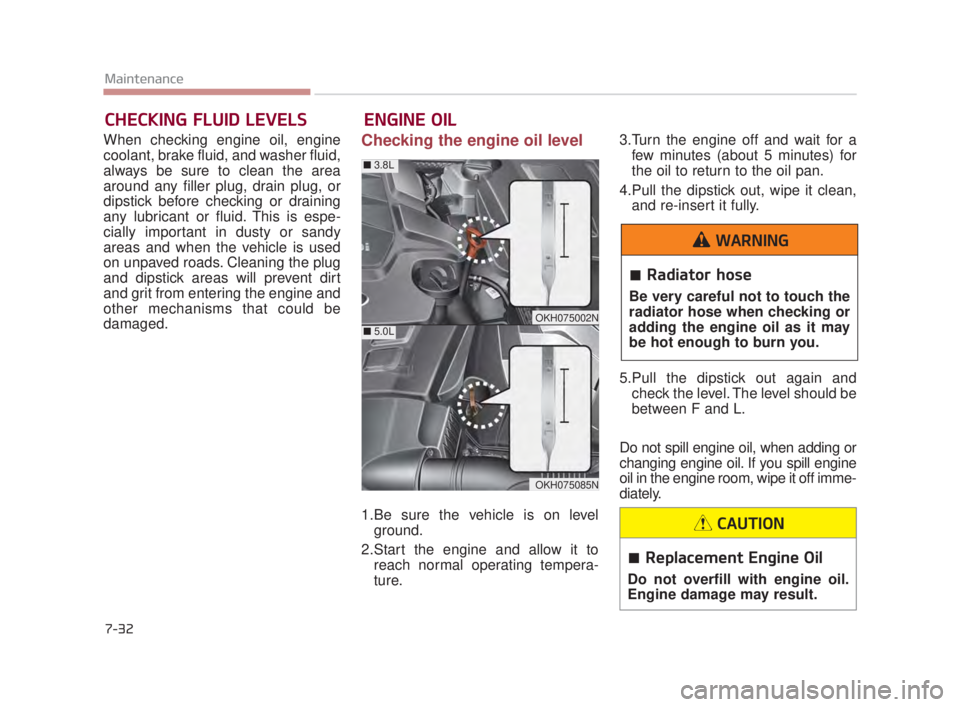
7-32
Maintenance
ENGINE OIL
CHECKING FLUID LEVELS
When checking engine oil, engine
coolant, brake fluid, and washer fluid,
always be sure to clean the area
around any filler plug, drain plug, or
dipstick before checking or draining
any lubricant or fluid. This is espe-
cially important in dusty or sandy
areas and when the vehicle is used
on unpaved roads. Cleaning the plug
and dipstick areas will prevent dirt
and grit from entering the engine and
other mechanisms that could be
damaged.Checking the engine oil level
1.Be sure the vehicle is on level
ground.
2.Start the engine and allow it to reach normal operating tempera-
ture. 3.Turn the engine off and wait for a
few minutes (about 5 minutes) for
the oil to return to the oil pan.
4.Pull the dipstick out, wipe it clean, and re-insert it fully.
5.Pull the dipstick out again and check the level. The level should be
between F and L.
Do not spill engine oil, when adding or
changing engine oil. If you spill engine
oil in the engine room, wipe it off imme-
diately.
Replacement Engine Oil
Do not overfill with engine oil.
Engine damage may result.
CAUTION
Radiator hose
Be very careful not to touch the
radiator hose when checking or
adding the engine oil as it may
be hot enough to burn you.
WARNING
OKH075002N
OKH075085N
■ 3.8L
■ 5.0L
KH USA 7:2018 4/14/2017 6:37 PM Page 32
Page 446 of 544
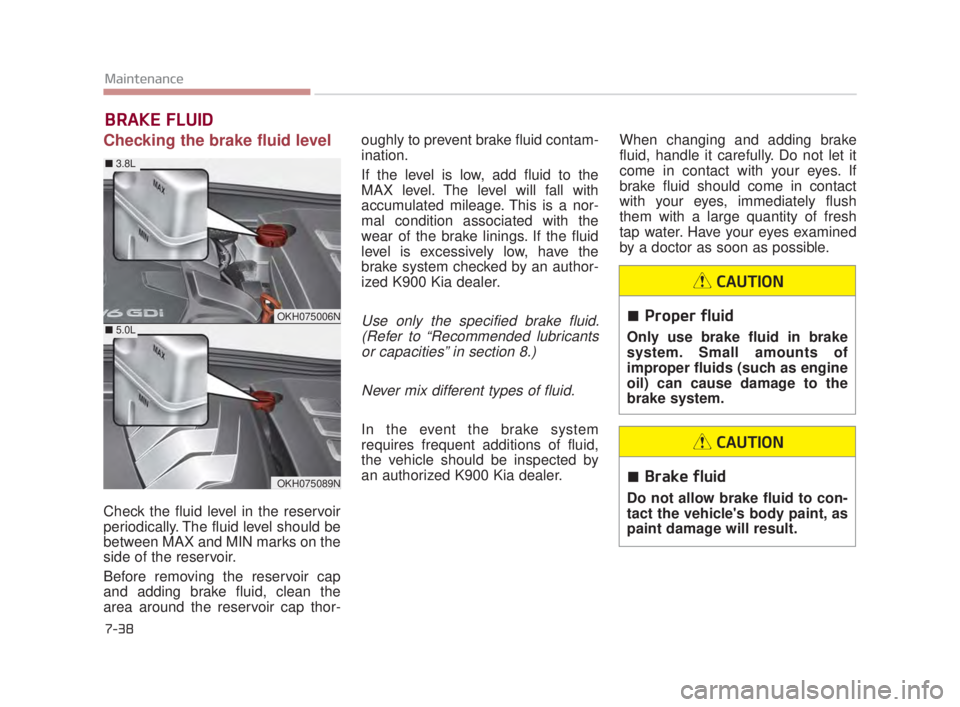
7-38
Maintenance
BRAKE FLUID
Checking the brake fluid level
Check the fluid level in the reservoir
periodically. The fluid level should be
between MAX and MIN marks on the
side of the reservoir.
Before removing the reservoir cap
and adding brake fluid, clean the
area around the reservoir cap thor-oughly to prevent brake fluid contam-
ination.
If the level is low, add fluid to the
MAX level. The level will fall with
accumulated mileage. This is a nor-
mal condition associated with the
wear of the brake linings. If the fluid
level is excessively low, have the
brake system checked by an author-
ized K900 Kia dealer.
Use only the specified brake fluid.
(Refer to “Recommended lubricantsor capacities” in section 8.)
Never mix different types of fluid.
In the event the brake system
requires frequent additions of fluid,
the vehicle should be inspected by
an authorized K900 Kia dealer. When changing and adding brake
fluid, handle it carefully. Do not let it
come in contact with your eyes. If
brake fluid should come in contact
with your eyes, immediately flush
them with a large quantity of fresh
tap water. Have your eyes examined
by a doctor as soon as possible.
Proper fluid
Only use brake fluid in brake
system. Small amounts of
improper fluids (such as engine
oil) can cause damage to the
brake system.
CAUTION
Brake fluid
Do not allow brake fluid to con-
tact the vehicle's body paint, as
paint damage will result.
CAUTION
OKH075006N
OKH075089N
■
3.8L
■ 5.0L
KH USA 7:2018 4/14/2017 6:37 PM Page 38
Page 465 of 544
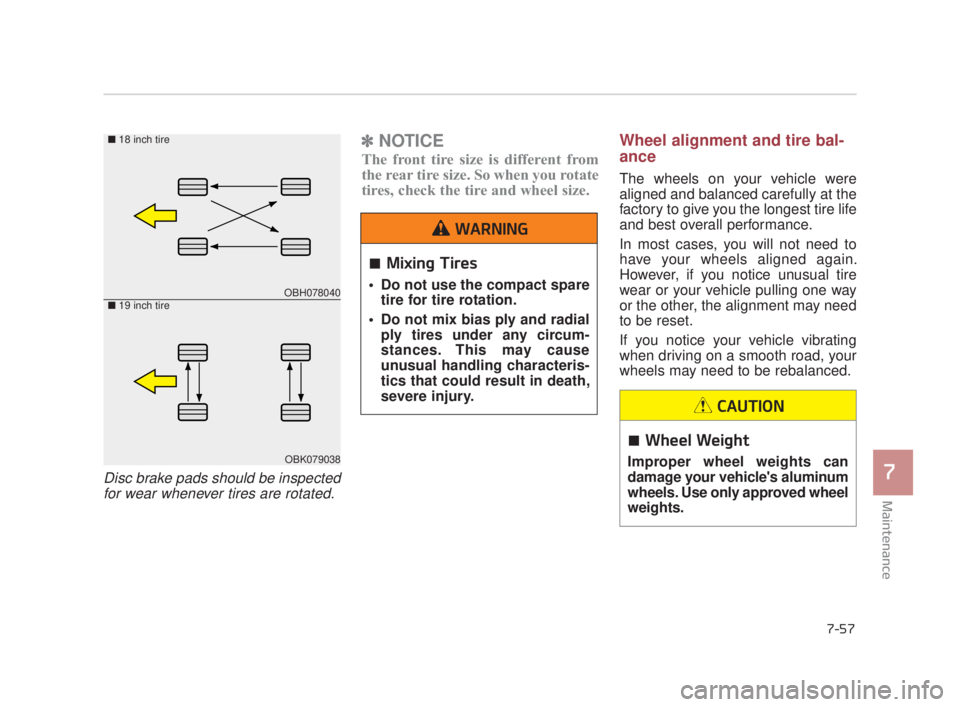
Maintenance
7
7-57
Disc brake pads should be inspectedfor wear whenever tires are rotated.
✽ NOTICE
The front tire size is different from
the rear tire size. So when you rotate
tires, check the tire and wheel size.
Wheel alignment and tire bal-
ance
The wheels on your vehicle were
aligned and balanced carefully at the
factory to give you the longest tire life
and best overall performance.
In most cases, you will not need to
have your wheels aligned again.
However, if you notice unusual tire
wear or your vehicle pulling one way
or the other, the alignment may need
to be reset.
If you notice your vehicle vibrating
when driving on a smooth road, your
wheels may need to be rebalanced.
OBH078040
OBK079038
■
18 inch tire
■ 19 inch tire
Mixing Tires
Do not use the compact spare
tire for tire rotation.
Do not mix bias ply and radial ply tires under any circum-
stances. This may cause
unusual handling characteris-
tics that could result in death,
severe injury.
WARNING
Wheel Weight
Improper wheel weights can
damage your vehicle's aluminum
wheels. Use only approved wheel
weights.
CAUTION
KH USA 7:2018 4/14/2017 6:39 PM Page 57
Page 466 of 544
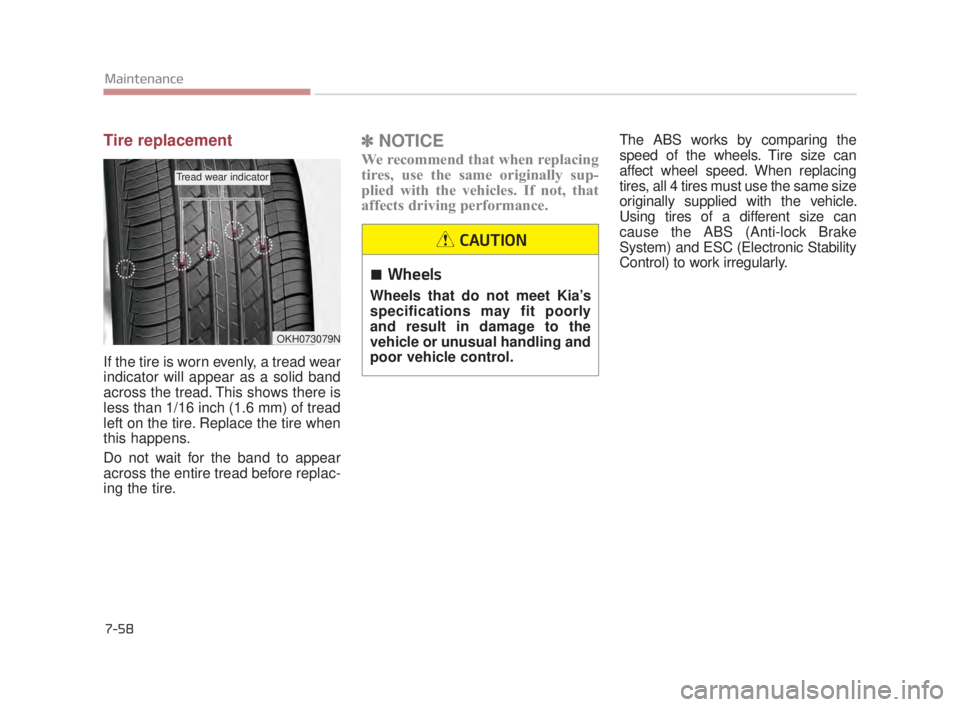
7-58
Maintenance
Tire replacement
If the tire is worn evenly, a tread wear
indicator will appear as a solid band
across the tread. This shows there is
less than 1/16 inch (1.6 mm) of tread
left on the tire. Replace the tire when
this happens.
Do not wait for the band to appear
across the entire tread before replac-
ing the tire.
✽NOTICE
We recommend that when replacing
tires, use the same originally sup-
plied with the vehicles. If not, that
affects driving performance.
The ABS works by comparing the
speed of the wheels. Tire size can
affect wheel speed. When replacing
tires, all 4 tires must use the same size
originally supplied with the vehicle.
Using tires of a different size can
cause the ABS (Anti-lock Brake
System) and ESC (Electronic Stability
Control) to work irregularly.
OKH073079N
Tread wear indicator
Wheels
Wheels that do not meet Kia’s
specifications may fit poorly
and result in damage to the
vehicle or unusual handling and
poor vehicle control.
CAUTION
KH USA 7:2018 4/14/2017 6:39 PM Page 58